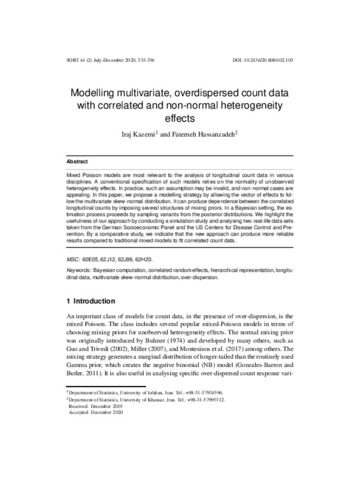Modelling multivariate, overdispersed count data with correlated and non-normal heterogeneity effects

Cita com:
hdl:2117/362103
Tipus de documentArticle
Data publicació2020-12-17
EditorInstitut d'Estadística de Catalunya
Condicions d'accésAccés obert
Llevat que s'hi indiqui el contrari, els
continguts d'aquesta obra estan subjectes a la llicència de Creative Commons
:
Reconeixement-NoComercial-SenseObraDerivada 3.0 Espanya
Abstract
Mixed Poisson models are most relevant to the analysis of longitudinal count data in various disciplines. A conventional specification of such models relies on the normality of unobserved heterogeneity effects. In practice, such an assumptionmay be invalid, and non-normal cases are appealing. In this paper, we propose a modelling strategy by allowing the vector of effects to follow the multivariate skew-normal distribution. It can produce dependence between the correlated longitudinal counts by imposing several structures of mixing priors. In a Bayesian setting, the estimation process proceeds by sampling variants from the posterior distributions. We highlight the usefulness of our approach by conducting a simulation study and analysing two real-life data sets taken from the German Socioeconomic Panel and the US Centers for Disease Control and Prevention. By a comparative study, we indicate that the new approach can produce more reliable results compared to traditional mixed models to fit correlated count data.
CitacióKazemi, I.; Hassanzadeh, F. Modelling multivariate, overdispersed count data with correlated and non-normal heterogeneity effects. "SORT", 17 Desembre 2020, vol. 44, núm. 2, p. 335-356.
ISSN1696-2281
| Fitxers | Descripció | Mida | Format | Visualitza |
|---|---|---|---|---|
| 44.2.5.Kazemi-Hassanzadeh.pdf | 459,2Kb | Visualitza/Obre | ||
| 44.2.5.Kazemi-Hassanzadeh.zip | 162,1Kb | application/zip | Visualitza/Obre |


